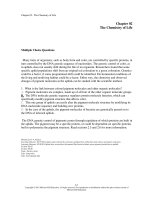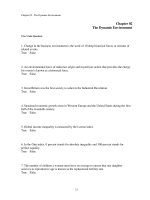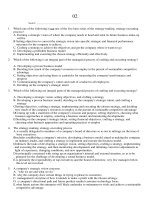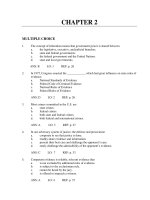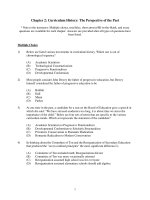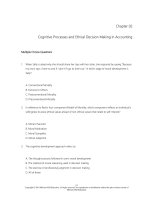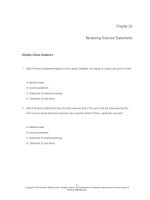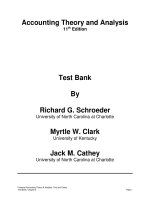Ethical obligations and decision making in accounting text and cases 3rd edition mintz test bank
Bạn đang xem bản rút gọn của tài liệu. Xem và tải ngay bản đầy đủ của tài liệu tại đây (271.44 KB, 35 trang )
Chapter 02
Cognitive Processes and Ethical Decision Making in Accounting
Multiple Choice Questions
1.
When Sally is asked why she should share her toys with her sister, she responds by saying "Because
my mom says I have to and if I don't I'll go to time-out." In which stage of moral development is
Sally?
A. Conventional Morality
B. Fairness to Others
C. Postconventional Morality
D. Preconventional Morality
2.
In reference to Rest's four-component Model of Morality, which component reflects an individual's
willingness to place ethical values ahead of non-ethical values that relate to self-interest?
A. Moral Character
B. Moral Motivation
C. Moral Sympathy
D. Moral Judgment
3.
The cognitive development approach refers to:
A. The thought process followed in one's moral development
B. The method of moral reasoning used in decision making
C. The exercise of professional judgment in decision making
D. All of these
2-1
Copyright © 2014 McGraw-Hill Education. All rights reserved. No reproduction or distribution without the prior written consent of
McGraw-Hill Education.
4.
Kohlberg's model can best be described as:
A. The various phases in one's moral development and related levels of moral reasoning
B. A model of ethical action that is based on one's moral development
C. A predictive tool to determine how a person will reason ethically based on one's moral
development
D. A model of age-specific levels of moral reasoning
5.
In the "Heinz and the Drug" case described in the chapter, Heinz's actions falls into which of
Kohlberg's stages?
A. Stage 1
B. Stage 2
C. Stage 3
D. Stage 4
6.
Heinz stole the drug because:
A. He loved his wife
B. He couldn't come up with all the money to pay for it
C. He was afraid his wife would die without the drug
D. All of these
7.
In stage 1 of Kohlberg's model, ethical reasoning is motivated by:
A. Fear of punishment
B. Satisfaction of one's needs
C. Following the law
D. Acting based on universal ethical principles
2-2
Copyright © 2014 McGraw-Hill Education. All rights reserved. No reproduction or distribution without the prior written consent of
McGraw-Hill Education.
8.
In stage 3 of Kohlberg's model, ethical reasoning is motivated by:
A. Satisfaction of one's needs
B. Acting in the best interests of others
C. Upholding the rights, values, and legal contracts of society
D. Acting based on universal principles
9.
In stage 5 of Kohlberg's model, ethical reasoning is motivated by:
A. Acting in the best interests of others
B. Following the law
C. Upholding the rights, values, and legal contracts of society
D. Acting based on universal principles
10. Individuals who reason at stage 6 incorporate ethical reasoning based on:
A. The morality of law and duty to the social order
B. A rational calculation of benefits and harms to society
C. Universal ethical principles
D. All of these
11. A client asks his accountant to ignore a mistake which overstated the accounts receivable account.
The accountant decides that the accounts receivable account has to be corrected to state the
correct amount. The accountant makes his decision based on his duty to society, respect for
authority, and maintaining the social order. Which stage of Kohlberg' Stages of Moral Development
is the accounting reasoning?
A. Stage 2
B. Stage 3
C. Stage 4
D. Stage 5
2-3
Copyright © 2014 McGraw-Hill Education. All rights reserved. No reproduction or distribution without the prior written consent of
McGraw-Hill Education.
12. The ethical domain in accounting and auditing refers to:
A. The important constituent groups affected by accounting and auditing work
B. The stages of the moral development of accountants and auditors
C. The decision making process followed by accountants and auditors
D. All of these
13. The results of studies indicate that CPAs reason primarily at:
A. Stages 1 and 2
B. Stages 2 and 3
C. Stages 3 and 4
D. Stages 4 and 5
14. Rest's "Four Component Model of Morality" can best be described as:
A. A description of the values that influence ethical decision making
B. A model of the relationship between ethical action and one's level of moral development
C. A model of moral judgment based on one's possession of certain virtues of behavior
D. All of these
15. Assume you were assigned a term paper and decided to surf the web to identify a provider of
papers for a fee. You chose what you thought was the best paper available. With respect to Rest's
model of morality it can be said that:
A. Your actions lack moral sensitivity
B. You are reasoning at stage 1
C. You are making judgments based on the utilitarian method
D. You lack the courage of your convictions
2-4
Copyright © 2014 McGraw-Hill Education. All rights reserved. No reproduction or distribution without the prior written consent of
McGraw-Hill Education.
16. The actions of Sherron Watkins in the Enron case appears to reflect each of the following except
for:
A. Moral sensitivity
B. Egoism
C. Enlightened egoism
D. Professional skepticism
17. Yvonne is preparing a tax return for Jack. Jack wants to claim his nephew as a dependent even
though he does not meet the criteria. Jack says if Yvonne does not list his nephew as a dependent,
he will fire her and find a new tax accountant. Yvonne refuses because it is illegal to claim a
dependent that does not meet the qualifications. Based on Yvonne's decision, she is likely
reasoning in which stage of Kohlberg's moral development model?
A. Stage 2
B. Stage 3
C. Stage 4
D. Stage 5
18. James Rest's model of ethical action involves four components inherent to the ethical decisionmaking process. Which of the following relates to a person's moral judgment?
A. Interpreting a situation as a moral dilemma
B. Willingness to place ethical values ahead of non-ethical values
C. Intention to act ethically aligning to his values
D. Outcome of one's prescriptive reasoning
2-5
Copyright © 2014 McGraw-Hill Education. All rights reserved. No reproduction or distribution without the prior written consent of
McGraw-Hill Education.
19. Thorne's "Integrated Model of Ethical Decision Making" can best be described as:
A. A depiction of a model of moral development
B. A depiction of how the Principles in the AICPA Code of Professional Conduct influences decision
making
C. A model of the role of virtue in decision making
D. A model of the role of moral development and virtue in decision making
20. In Thorne's model of ethical decision making, the instrumental virtues relate to:
A. Moral sensitivity
B. Ethical reasoning
C. Ethical motivation
D. Ethical character
21. The ethical decision making model described in the chapter helps to:
A. Organize the various elements of ethical reasoning and professional judgment
B. Evaluate stakeholder interests using ethical reasoning
C. Identify and select alternative courses of action
D. All of these
22. The importance of framing the ethical issue in the decision making model is:
A. Identify the stakeholders affected by intended actions
B. Evaluating alternative courses of action using moral reasoning methods
C. Identify the accounting issues present in a case
D. Providing a perspective to apply the decision making model to specific facts of the case
2-6
Copyright © 2014 McGraw-Hill Education. All rights reserved. No reproduction or distribution without the prior written consent of
McGraw-Hill Education.
23. Each of the following is an element of the operational issues to be considered in the decision
making model except for the:
A. Culture of the organization
B. Method of moral reasoning
C. Internal controls
D. Corporate governance system
24. Each of the following considerations should help to evaluate alternative courses of action in the
decision making model except for:
A. Whether the alternatives are consistent with professional standards
B. Whether the alternatives are consistent with firm policies and its own code of ethics
C. The stage of moral development of the decision maker
D. The potential harms and benefits of alternative courses of action
25. Wanda is faced with an ethical dilemma. She knows her supervisor, the CFO, wants to accelerate
the recoding of revenue to an earlier period to "make the numbers," but Wanda is convinced this
would violate GAAP. If Wanda reasons at stage 4 of Kohlberg's model she is most likely to:
A. Make a decision based on what is in her own best interests
B. Consider the interests of the stakeholders but decide based on what is in her best interests
C. Refuse to record the transaction as desired by the CFO
D. Inform the board of directors of the difference of opinion with the CFO
2-7
Copyright © 2014 McGraw-Hill Education. All rights reserved. No reproduction or distribution without the prior written consent of
McGraw-Hill Education.
26. Keesha is the CEO of a publicly-owned company. She was informed by the CFO that the company's
earnings were down 30 percent from the prior year due to the recession. The company's stock
price has declined by 20 percent. The CFO comes up with a scheme to hide debt and inflate
revenues by selling underperforming assets to a special purpose entity affiliated with the company.
Keesha is concerned about possible effects on the creditors but ultimately she agrees to the
accounting. Keesha is reasoning at:
A. Stage 1
B. Stage 2
C. Stage 3
D. Stage 4
27. Rosie is the external auditor of Texas Two Steps, a privately-owned dance company in Texas. Rosie
believes the owner of the company is skimming cash off the top. She approaches the owner who
explains that the money will be replaced in the following month after he refinances his house. Rosie
accepts the owner's explanation but reclassifies the expenditure as a receivable of the company
from Rosie. Rosie's reasoning best reflects:
A. Stage 1
B. Stage 2
C. Stage 3
D. Stage 4
28. Steve is in charge of accounting for the purchase of equipment at Cal Works, Inc. The company has
a policy that all expenditures less than $1,000 must be expensed. Steve decides to take a $900
expenditure and separate $600 one and combine them into one $1,500 expenditure so that the
total can be capitalized thereby eliminating the effects on income. Steve's actions can be
characterized as:
A. Lacking in of moral sensitivity
B. Lacking in professional skepticism
C. Loyal to the company's best interests
D. All of these
2-8
Copyright © 2014 McGraw-Hill Education. All rights reserved. No reproduction or distribution without the prior written consent of
McGraw-Hill Education.
29. Role expectation or approval from others is a motive for doing right in which stage of Kohlberg's
moral reasoning?
A. Fairness to others
B. Obedience
C. Self-chosen principles
D. Law and order
30. At which stage of Kohlberg's view on ethical development is an individual's actions influenced by
group norms?
A. Stage 1
B. Stage 2
C. Stage 3
D. Stage 4
31. How does Gilligan evaluate the solution to Heinz's dilemma?
A. Women think saving a life is more important than keeping the law.
B. Men think keeping the law is more important than saving a life.
C. Men tend to think in terms of justice, and women in terms of caring.
D. Men misunderstand and women understand.
32. Rest's components of a moral model include all but
A. Moral sensitivity
B. Moral development
C. Moral judgment
D. Moral character
2-9
Copyright © 2014 McGraw-Hill Education. All rights reserved. No reproduction or distribution without the prior written consent of
McGraw-Hill Education.
33. Moral sensitivity can be summarized as
A. Being able to think of others first
B. Being able to identify the best course of action
C. Being able to identify an ethical situation
D. Being able to react quickly
34. What needs to be coupled with moral motivation to act on moral judgment?
A. Courage
B. External pressures
C. Loyalty
D. Internal pressures
35. Kohlberg's model suggests that a person
A. is morally developed early in life and will not change
B. continues to change decision priorities with education and experiences
C. may change up or down one stage upon becoming an adult
D. may only go backwards through the stages upon becoming an adult
36. What are the implications of reasoning at stages 3 and 4?
A. A CPA unable to apply technical accounting standards is unlikely to be influenced by others.
B. A CPA is unlikely to be influenced by rules or authority.
C. A CPA is unlikely to be influenced or give into pressures.
D. A CPA unable to apply technical accounting standards is likely to be influenced by others.
2-10
Copyright © 2014 McGraw-Hill Education. All rights reserved. No reproduction or distribution without the prior written consent of
McGraw-Hill Education.
37. What should be the first step in decision making when faced with an ethical dilemma?
A. Choose an ethical theory to follow
B. Discuss with others your options
C. Get the facts surrounding the problem
D. Determine consequences
38. Diem-Thi Le felt retaliated against for whistle-blowing at the DCAA. Her persistence and
determination to see audits change at DCAA exemplify
A. Moral Character
B. Moral Motivation
C. Moral Judgment
D. Moral Sensitivity
39. The best way to characterize the efforts of Diem-Thi Le is that of a
A. Disgruntled employee
B. Whistleblower
C. Member of the audit committee
D. The director of the DCAA
40. The actions of Diem-Thi Li best illustrate
A. System 1 thinking
B. System 2 thinking
C. Moral blindness
D. Pursuit of self-interests
2-11
Copyright © 2014 McGraw-Hill Education. All rights reserved. No reproduction or distribution without the prior written consent of
McGraw-Hill Education.
41. Cynthia Cooper's actions in the WorldCom case can be best characterized as demonstrating:
A. Persistence and independence
B. Persistence and courage
C. Courage and loyalty
D. Persistence and loyalty
42. In the Better Boston Beans case, what is the ethical dilemma facing Cindie?
A. Loyalty of co-worker versus trust of co-worker
B. Trust of co-worker versus the honesty of the workplace
C. Honesty of the workplace versus the privacy of an individual
D. Privacy of an individual versus loyalty of co-worker
43. The ethical dilemma for Brenda in "The Tax Return" case can best be described as a:
A. Conflict between loyalty to one's supervisor and doing the right thing
B. Conflict between reporting an item of taxable income and ignoring it
C. Lack of independence due to ties to the client entity
D. All of these
44. The ethical dilemma in the "Shifty Industries" case can best be described as whether to:
A. Use tax depreciation for financial reporting issues
B. Manipulating earnings to maximize net income
C. Maximizing section 179 depreciation expense
D. Minimizing depreciation expense to maximize net income
2-12
Copyright © 2014 McGraw-Hill Education. All rights reserved. No reproduction or distribution without the prior written consent of
McGraw-Hill Education.
45. In "Blues Brothers" the initial dilemma facing the internal accountant is whether to:
A. Prematurely record revenue and give in to pressure from the supervisor
B. Record revenue correctly and start looking for a new job
C. Record revenue correctly and go to the "Blues Brothers" and seek to change their minds
D. Record revenue correctly refuse to budge from your position
46. Kevin Greenberg's actions in the "Supreme Designs" case can be said to have been:
A. Selfish, in that he only thought of his own interests
B. Disloyal to the company
C. Unethical because he wrote checks to himself for unauthorized checks
D. Undertaken with the intent to help out his supervisor
47. The "Milton Manufacturing" case illustrates:
A. What can go wrong when a company sets a policy that potentially harms one area of its
operations
B. How the failure to exercise professional skepticism can cloud objective judgment
C. The pressure that can be placed on accountants by top management
D. All of these
48. The main accounting issue in the Juggyfroot case is:
A. How to account for prepaid capacity
B. How to account for and report special purpose entities
C. How to account for inventory declines
D. How to account for investments in marketable securities
2-13
Copyright © 2014 McGraw-Hill Education. All rights reserved. No reproduction or distribution without the prior written consent of
McGraw-Hill Education.
49. In the Phar-Mor case, Pat Finn's actions reflect ethical reasoning at what stage?
A. Stage 1
B. Stage 2
C. Stage 3
D. Stage 4
50. In the Gateway Hospital case, Troy:
A. Wants to be treated the same as Kristen with respect to expense reimbursement
B. Wants to be treated consistently with the company policy on expense reimbursement
C. Wants to be treated differently than Kristen with respect to expense reimbursement because of
personal considerations
D. Believes the company's reimbursement policy is fair
Essay Questions
51. Distinguish between each stage of ethical reasoning in Kohlberg's Model of Moral Development
and related effects on accounting decision-making when there is a difference of opinion with
management on the proper recording of a material amount of expense.
2-14
Copyright © 2014 McGraw-Hill Education. All rights reserved. No reproduction or distribution without the prior written consent of
McGraw-Hill Education.
52. At which stage of moral development are most accountants and auditors with respect to their
decision making? What factors are responsible for their being at that stage? How does the stage of
ethical reasoning potentially effect whether an accountant would give in to pressure from a
supervisor to "cook the books"?
53. How does the "ethical domain" in accounting and auditing influence professional judgment?
54. Explain each of the four components of Rest's Model of Morality.
2-15
Copyright © 2014 McGraw-Hill Education. All rights reserved. No reproduction or distribution without the prior written consent of
McGraw-Hill Education.
55. Compare and contrast the steps taken by Sherron Watkins and Cynthia Cooper in bringing their
concerns to top management. Be sure to link your discussion to the stage of moral development
each person was at in their decision making.
56. Explain how virtue interacts with moral development in Thorne's Integrated Model of Ethical
Decision Making.
57. Describe the components and objectives of each step in the integrated ethical decision making
process explained in the chapter.
2-16
Copyright © 2014 McGraw-Hill Education. All rights reserved. No reproduction or distribution without the prior written consent of
McGraw-Hill Education.
58. Use the comprehensive decision making process to evaluate the actions of Cynthia Cooper as
described in the WorldCom case.
59. As an executive in a mid-sized manufacturing firm, Cal finds himself thrown together with Harry,
who works for a different unit of the firm. He and Harry are in the same community; their children
are in the same schools; they often show up at the same social functions; and they play golf
together fairly frequently.
One day, to Cal's deep dismay, he hears that Harry had been implicated in some financial
irregularities at work. The issues while serious leave some room for doubt. There is reason to think
Harry got ensnared by regulations, though he may have afterwards tried to cover up that
entanglement by being less than forthright. Cal has heard from Harry that he was uncomfortable
with the way he handled one of the contentious matters. Using Kohlberg's model of moral
development, explain what Cal should do with the information he has discovered about Harry.
2-17
Copyright © 2014 McGraw-Hill Education. All rights reserved. No reproduction or distribution without the prior written consent of
McGraw-Hill Education.
60. Diem-Thi Le took actions at the DCAA that jeopardized her position at the agency. What motivated
her to act as she did in the case?
2-18
Copyright © 2014 McGraw-Hill Education. All rights reserved. No reproduction or distribution without the prior written consent of
McGraw-Hill Education.
Chapter 02 Cognitive Processes and Ethical Decision Making in
Accounting Answer Key
Multiple Choice Questions
1.
When Sally is asked why she should share her toys with her sister, she responds by saying
"Because my mom says I have to and if I don't I'll go to time-out." In which stage of moral
development is Sally?
A. Conventional Morality
B. Fairness to Others
C. Postconventional Morality
D. Preconventional Morality
2.
In reference to Rest's four-component Model of Morality, which component reflects an
individual's willingness to place ethical values ahead of non-ethical values that relate to selfinterest?
A. Moral Character
B. Moral Motivation
C. Moral Sympathy
D. Moral Judgment
3.
The cognitive development approach refers to:
A. The thought process followed in one's moral development
B. The method of moral reasoning used in decision making
C. The exercise of professional judgment in decision making
D. All of these
2-19
Copyright © 2014 McGraw-Hill Education. All rights reserved. No reproduction or distribution without the prior written consent of
McGraw-Hill Education.
4.
Kohlberg's model can best be described as:
A. The various phases in one's moral development and related levels of moral reasoning
B. A model of ethical action that is based on one's moral development
C. A predictive tool to determine how a person will reason ethically based on one's moral
development
D. A model of age-specific levels of moral reasoning
5.
In the "Heinz and the Drug" case described in the chapter, Heinz's actions falls into which of
Kohlberg's stages?
A. Stage 1
B. Stage 2
C. Stage 3
D. Stage 4
6.
Heinz stole the drug because:
A. He loved his wife
B. He couldn't come up with all the money to pay for it
C. He was afraid his wife would die without the drug
D. All of these
7.
In stage 1 of Kohlberg's model, ethical reasoning is motivated by:
A. Fear of punishment
B. Satisfaction of one's needs
C. Following the law
D. Acting based on universal ethical principles
2-20
Copyright © 2014 McGraw-Hill Education. All rights reserved. No reproduction or distribution without the prior written consent of
McGraw-Hill Education.
8.
In stage 3 of Kohlberg's model, ethical reasoning is motivated by:
A. Satisfaction of one's needs
B. Acting in the best interests of others
C. Upholding the rights, values, and legal contracts of society
D. Acting based on universal principles
9.
In stage 5 of Kohlberg's model, ethical reasoning is motivated by:
A. Acting in the best interests of others
B. Following the law
C. Upholding the rights, values, and legal contracts of society
D. Acting based on universal principles
10.
Individuals who reason at stage 6 incorporate ethical reasoning based on:
A. The morality of law and duty to the social order
B. A rational calculation of benefits and harms to society
C. Universal ethical principles
D. All of these
11.
A client asks his accountant to ignore a mistake which overstated the accounts receivable
account. The accountant decides that the accounts receivable account has to be corrected to
state the correct amount. The accountant makes his decision based on his duty to society,
respect for authority, and maintaining the social order. Which stage of Kohlberg' Stages of
Moral Development is the accounting reasoning?
A. Stage 2
B. Stage 3
C. Stage 4
D. Stage 5
2-21
Copyright © 2014 McGraw-Hill Education. All rights reserved. No reproduction or distribution without the prior written consent of
McGraw-Hill Education.
12.
The ethical domain in accounting and auditing refers to:
A. The important constituent groups affected by accounting and auditing work
B. The stages of the moral development of accountants and auditors
C. The decision making process followed by accountants and auditors
D. All of these
13.
The results of studies indicate that CPAs reason primarily at:
A. Stages 1 and 2
B. Stages 2 and 3
C. Stages 3 and 4
D. Stages 4 and 5
14.
Rest's "Four Component Model of Morality" can best be described as:
A. A description of the values that influence ethical decision making
B. A model of the relationship between ethical action and one's level of moral development
C. A model of moral judgment based on one's possession of certain virtues of behavior
D. All of these
15.
Assume you were assigned a term paper and decided to surf the web to identify a provider of
papers for a fee. You chose what you thought was the best paper available. With respect to
Rest's model of morality it can be said that:
A. Your actions lack moral sensitivity
B. You are reasoning at stage 1
C. You are making judgments based on the utilitarian method
D. You lack the courage of your convictions
2-22
Copyright © 2014 McGraw-Hill Education. All rights reserved. No reproduction or distribution without the prior written consent of
McGraw-Hill Education.
16.
The actions of Sherron Watkins in the Enron case appears to reflect each of the following except
for:
A. Moral sensitivity
B. Egoism
C. Enlightened egoism
D. Professional skepticism
17.
Yvonne is preparing a tax return for Jack. Jack wants to claim his nephew as a dependent even
though he does not meet the criteria. Jack says if Yvonne does not list his nephew as a
dependent, he will fire her and find a new tax accountant. Yvonne refuses because it is illegal to
claim a dependent that does not meet the qualifications. Based on Yvonne's decision, she is
likely reasoning in which stage of Kohlberg's moral development model?
A. Stage 2
B. Stage 3
C. Stage 4
D. Stage 5
18.
James Rest's model of ethical action involves four components inherent to the ethical decisionmaking process. Which of the following relates to a person's moral judgment?
A. Interpreting a situation as a moral dilemma
B. Willingness to place ethical values ahead of non-ethical values
C. Intention to act ethically aligning to his values
D. Outcome of one's prescriptive reasoning
2-23
Copyright © 2014 McGraw-Hill Education. All rights reserved. No reproduction or distribution without the prior written consent of
McGraw-Hill Education.
19.
Thorne's "Integrated Model of Ethical Decision Making" can best be described as:
A. A depiction of a model of moral development
B. A depiction of how the Principles in the AICPA Code of Professional Conduct influences
decision making
C. A model of the role of virtue in decision making
D. A model of the role of moral development and virtue in decision making
20.
In Thorne's model of ethical decision making, the instrumental virtues relate to:
A. Moral sensitivity
B. Ethical reasoning
C. Ethical motivation
D. Ethical character
21.
The ethical decision making model described in the chapter helps to:
A. Organize the various elements of ethical reasoning and professional judgment
B. Evaluate stakeholder interests using ethical reasoning
C. Identify and select alternative courses of action
D. All of these
22.
The importance of framing the ethical issue in the decision making model is:
A. Identify the stakeholders affected by intended actions
B. Evaluating alternative courses of action using moral reasoning methods
C. Identify the accounting issues present in a case
D. Providing a perspective to apply the decision making model to specific facts of the case
2-24
Copyright © 2014 McGraw-Hill Education. All rights reserved. No reproduction or distribution without the prior written consent of
McGraw-Hill Education.
23.
Each of the following is an element of the operational issues to be considered in the decision
making model except for the:
A. Culture of the organization
B. Method of moral reasoning
C. Internal controls
D. Corporate governance system
24.
Each of the following considerations should help to evaluate alternative courses of action in the
decision making model except for:
A. Whether the alternatives are consistent with professional standards
B. Whether the alternatives are consistent with firm policies and its own code of ethics
C. The stage of moral development of the decision maker
D. The potential harms and benefits of alternative courses of action
25.
Wanda is faced with an ethical dilemma. She knows her supervisor, the CFO, wants to accelerate
the recoding of revenue to an earlier period to "make the numbers," but Wanda is convinced
this would violate GAAP. If Wanda reasons at stage 4 of Kohlberg's model she is most likely to:
A. Make a decision based on what is in her own best interests
B. Consider the interests of the stakeholders but decide based on what is in her best interests
C. Refuse to record the transaction as desired by the CFO
D. Inform the board of directors of the difference of opinion with the CFO
2-25
Copyright © 2014 McGraw-Hill Education. All rights reserved. No reproduction or distribution without the prior written consent of
McGraw-Hill Education.
